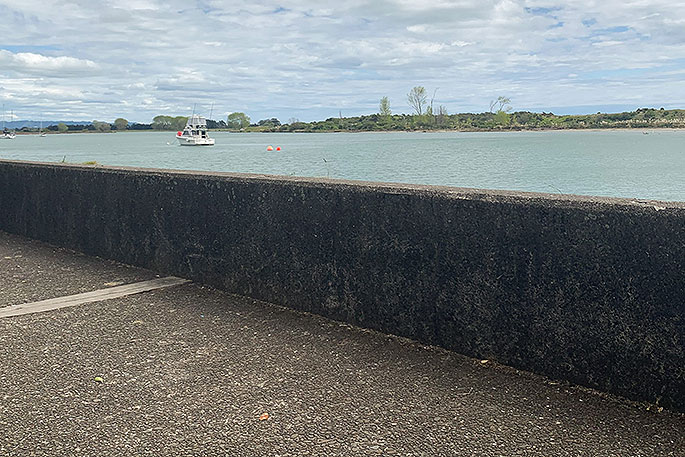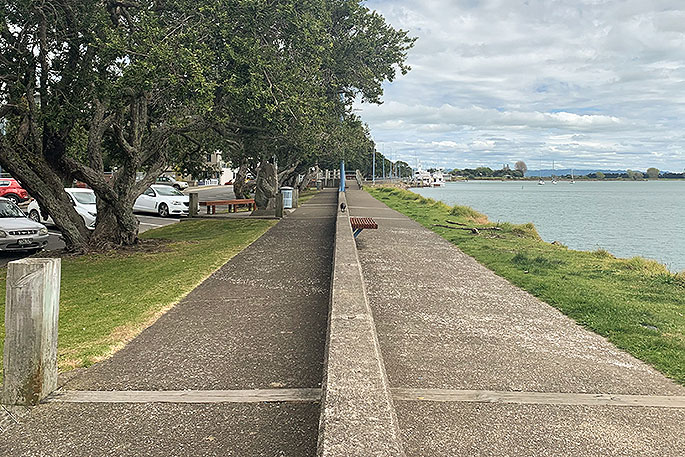Floodbanks in Whakatane's town centre are getting a much-needed upgrade to protect people and property against a one-in-100-year flood.
Bay of Plenty Regional Council staff presented Project Future Proof to Whakatane district councillors yesterday, which will address seepage issues and upgrade stopbanks and floodwalls surrounding the central business district.
Project manager Lars Thiel-Lardon says stopbanks next to Kakahoroa Drive and Quay Street had experienced seepage, particularly during the 2017 floods.
The presentation outlined how geotechnical investigations, together with flood data and climate change, have shown the existing flood defences would not protect the town centre in coming decades.
Seepage occurs when water makes its way under the stopbank through the sand layer and begins to seep out slowly onto the ground surface on the protected side.
In extreme cases, such as occurred in Edgecumbe, ground on the other side can begin to 'boil” and the washing-out of the ground underneath leads to stopbank failure.
This was also seen outside the Quay Street apartments in the 2017 flood.
'As guardians of the stopbanks we need to stop that seepage,” says Thiel-Lardon.
He says the regional council is investigating several measures such as inserting 500mm-wide steel sheets into the Kakahoroa Drive stopbank and the Quay Street floodwall to create an impermeable barrier.
This method is used around the world and can be seen in the Kopeopeo Canal near Awakeri.
The council was also looking at moving and raising the concrete flood wall along Quay Street, raising the floodbank along Mataatua Reserve and using hundreds of hectares of pasture as water detention basins.
None of these options are set in stone.
 Stopbanks alongside Mataatua Reserve and the reserve itself may be raised as part of the regional council's work. CHARLOTTE JONES / LDR
Stopbanks alongside Mataatua Reserve and the reserve itself may be raised as part of the regional council's work. CHARLOTTE JONES / LDR
Councillor Gerard van Beek asked why the regional council is considering sheet piles in the Whakatane stopbanks when the same method was not considered for Edgecumbe.
Thiel-Lardon says they are not preferred in Edgecumbe because pressure would build up leading to a failure, whereas in Whakatane the sheet piles could be inserted and not hit the bedrock.
The large metal sheet piles lengthen the seepage path for excess water to then be pumped back to the river.
The sheet piles also stop the formation of piping, where water flowing through the flood defence picks up foundation material and can lead to stopbank failure.
'This is not about stopping the seepage but rather controlling and slowing it,” says Thiel-Lardon.
van Beek says the Wairaka community was not pleased the last time the Mataatua Reserve stopbanks were raised and he won't be surprised if there is push back again.
He questions whether the stopbanks on both sides of the river will be raised.
Thiel-Lardon says if the regional council is to raise the stopbanks, it will also raise the reserve and gradually smooth it to 'look nice” rather than like a bund.
Stopbanks on the Piripai side of the river might not be raised if other flood protection work is successful.
Councillor Wilson James is concerned about what land the regional council might be using to create water detention basins.
Engineering manager Mark Townsend says it will be enhancing land that already suffered from flooding so it could hold more water, thereby alleviating pressure on stopbanks surrounding townships further downriver.
'For example, we could create a series of one metre high bunds, once the water enters one it can then cascade into the next."
He says the regional council will complete this work so it looks as natural as possible.
It's consulting with potentially affected landowners now.
He says if it is successful, stopbanks might not need to be raised in the CBD.
Deputy mayor Andrew Iles says he's concerned that 'once again, rural areas are the sacrificial lamb for the urban sector.
Townsend says regional council will do its 'utmost” to protect any settlement, rural or otherwise.
The town defence upgrade is one of the community resilience and flood protection projects that the regional council received support for through the Government's Crown Infrastructure Partners 'shovel-ready” fund for projects able to be undertaken in the short to medium term.




0 comments
Leave a Comment
You must be logged in to make a comment.